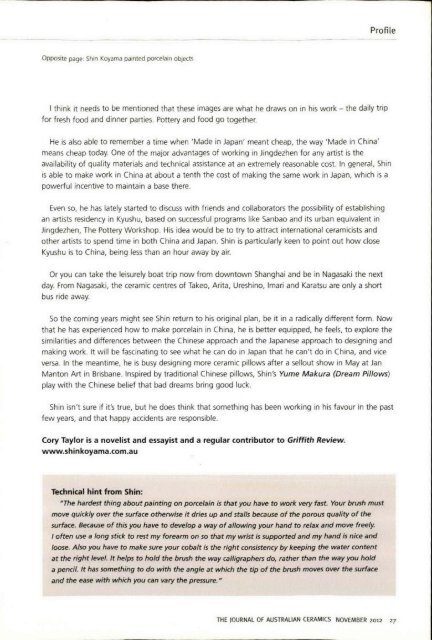The Journal of Australian Ceramics Vol 51 No 3 November 2012
Create successful ePaper yourself
Turn your PDF publications into a flip-book with our unique Google optimized e-Paper software.
Pr<strong>of</strong>ile<br />
Opposite page: Shin Koyama painted porcelain objects<br />
I think it needs to be mentioned that these images are what he draws on in his work - the daily trip<br />
for fresh food and dinner parties. Pottery and food go together.<br />
He is also able to remember a time when 'Made in Japan' meant cheap, the way 'Made in China'<br />
means cheap today. One <strong>of</strong> the major advantages <strong>of</strong> working in Jingdezhen for any artist is the<br />
availability <strong>of</strong> quality materials and technical assistance at an extremely reasonable cost. In general, Shin<br />
is able to male work in China at about a tenth the cost <strong>of</strong> making the same work in Japan, which is a<br />
powerful incentive to maintain a base there.<br />
Even so, he has lately started to discuss with friends and collaborators the possibility <strong>of</strong> establishing<br />
an artists residency in Kyushu, based on successful programs like Sanbao and its urban equivalent in<br />
Jingdezhen, <strong>The</strong> Pottery Workshop. His idea would be to try to attract international ceramicists and<br />
other artists to spend time in both China and Japan. Shin is particularly keen to point out how close<br />
Kyushu is to China, being less than an hour away by air.<br />
Or you can take the leisurely boat trip now from downtown Shanghai and be in Nagasaki the next<br />
day. From Nagasaki, the ceramic centres <strong>of</strong> Takeo, Arita, Ureshino, Imari and Karatsu are only a short<br />
bus ride away.<br />
So the coming years might see Shin return to his original plan, be it in a radically different form. <strong>No</strong>w<br />
that he has experienced how to make porcelain in China, he is better equipped, he feels, to explore the<br />
similarities and differences between the Chinese approach and the Japanese approach to designing and<br />
making work. It will be fascinating to see what he can do in Japan that he can't do in China, and vice<br />
versa. In the meantime, he is busy designing more ceramic pillows after a sellout show in May at Jan<br />
Manton Art in Brisbane. Inspired by traditional Chinese pillows, Shin's Yume Makura (Dream Pillows)<br />
play with the Chinese belief that bad dreams bring good luck.<br />
Shin isn't sure if it's true, but he does think that something has been working in his favour in the past<br />
few years, and that happy accidents are responsible.<br />
Cory Taylor is a novelist and essayist and a regular contributor to Griffith Review,<br />
www.shinkoyama.com.au<br />
Technical hint from Shin:<br />
" <strong>The</strong> hardest thing about painting on porcelain is that you have to work very fast. Your brush must<br />
move quickly over the surface otherwise it dries up and stalls because <strong>of</strong> the porous quality <strong>of</strong> the<br />
surface. Because <strong>of</strong> this you have to develop a way <strong>of</strong> allowing your hand to relax and move freely.<br />
I <strong>of</strong>ten use a long stick to rest my forearm on so that my wrist is supported and my hand is nice and<br />
loose. Also you have to make sure your cobalt is the right consistency by keeping the water content<br />
at the right level. It helps to hold the brush the way ca lligraphers do, rather than the way you hold<br />
a pencil. It has something to do with the angle at which the tip <strong>of</strong> the brush moves over the surface<br />
and the ease with which you can vary the pressure. "<br />
THE JOURNAL OF AUSTRALIAN CERAMICS NOVEMBER <strong>2012</strong> 27

















